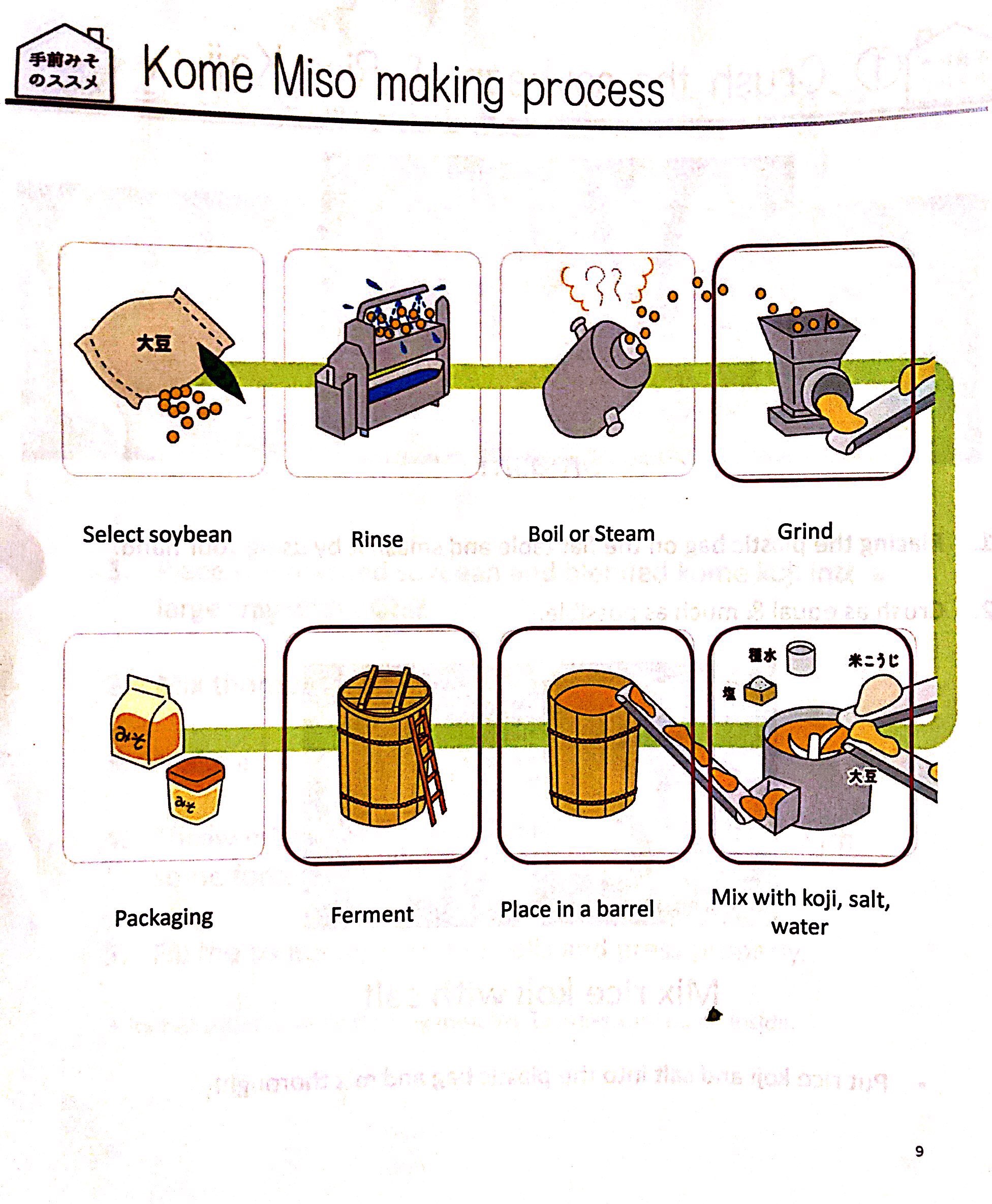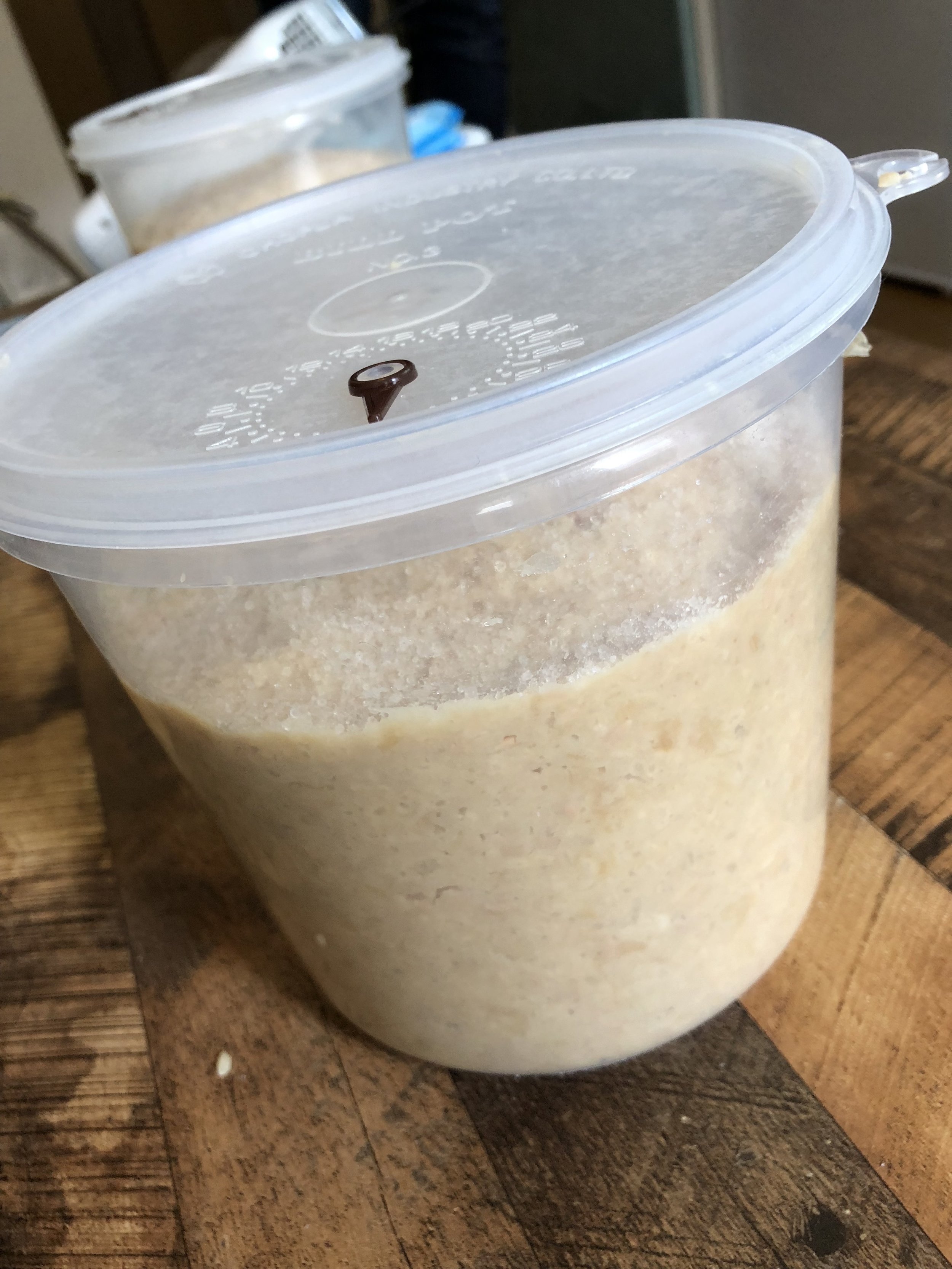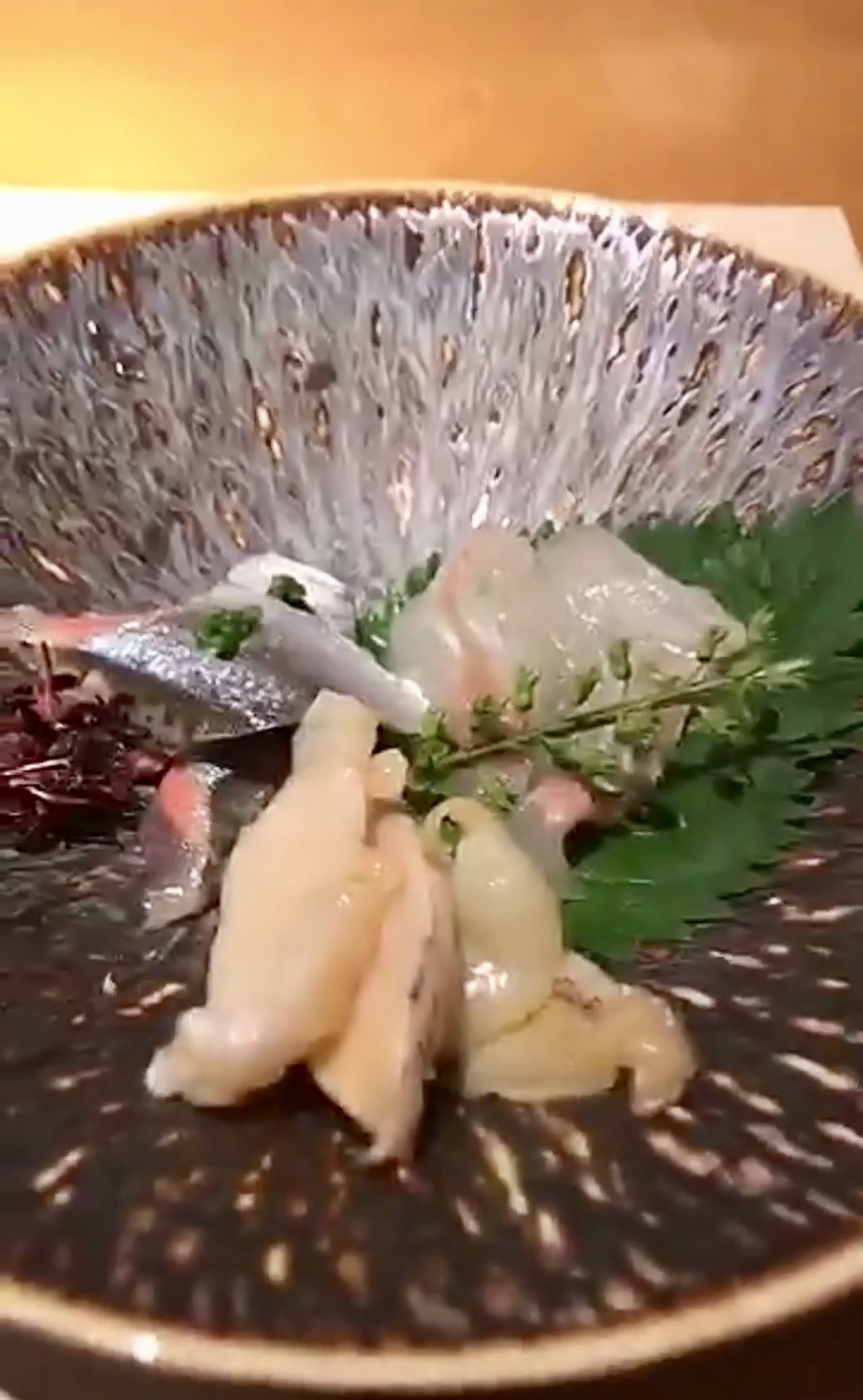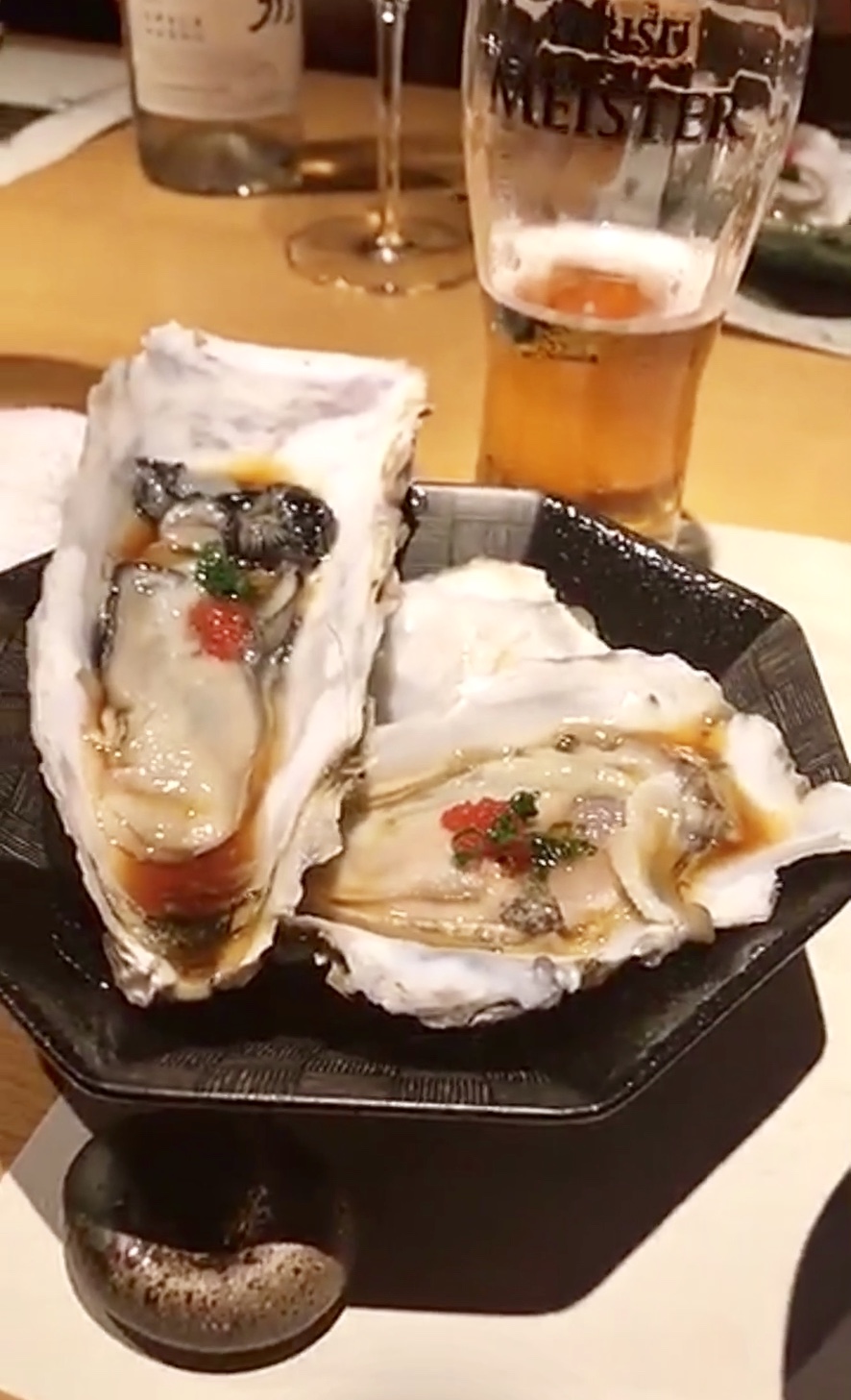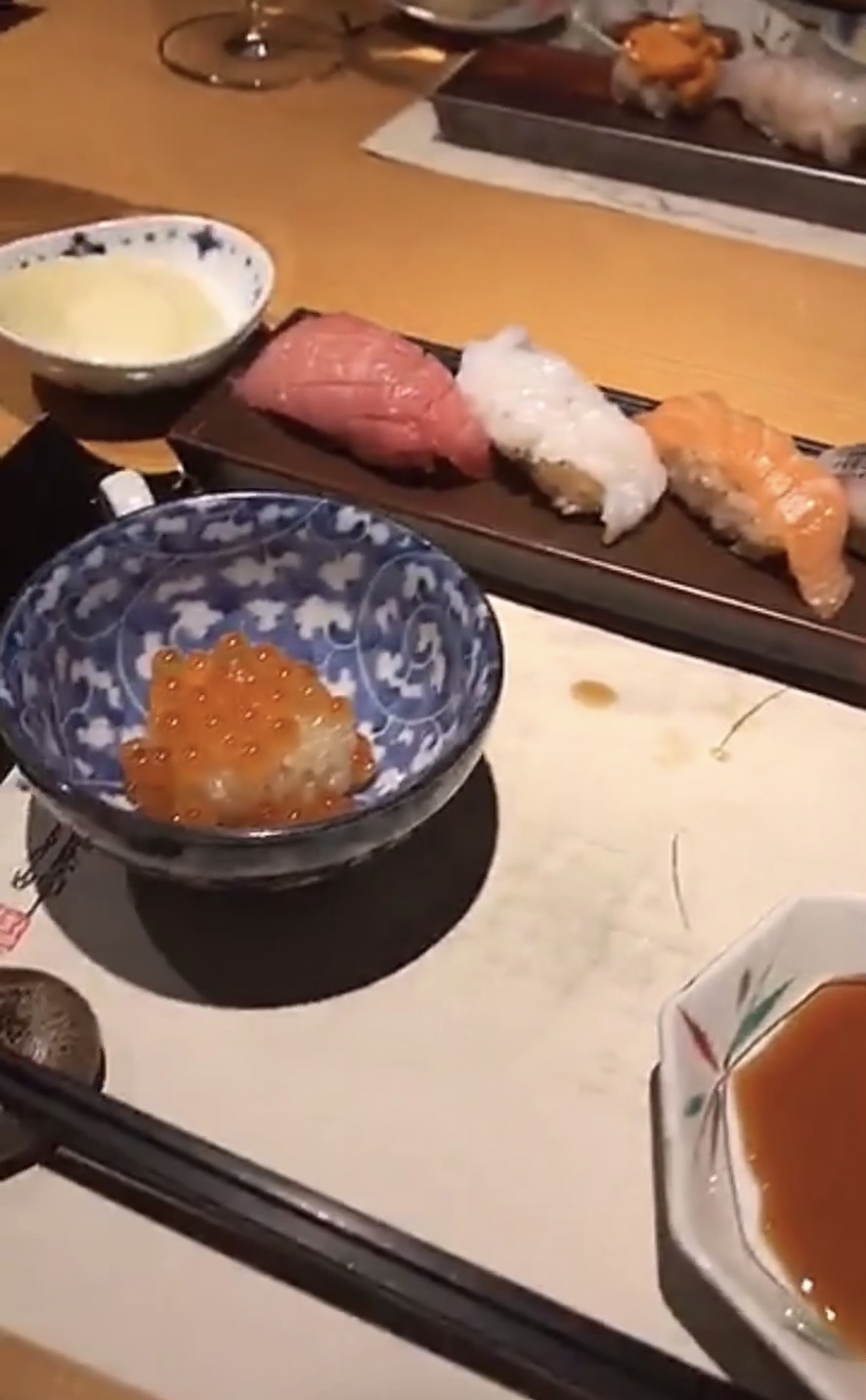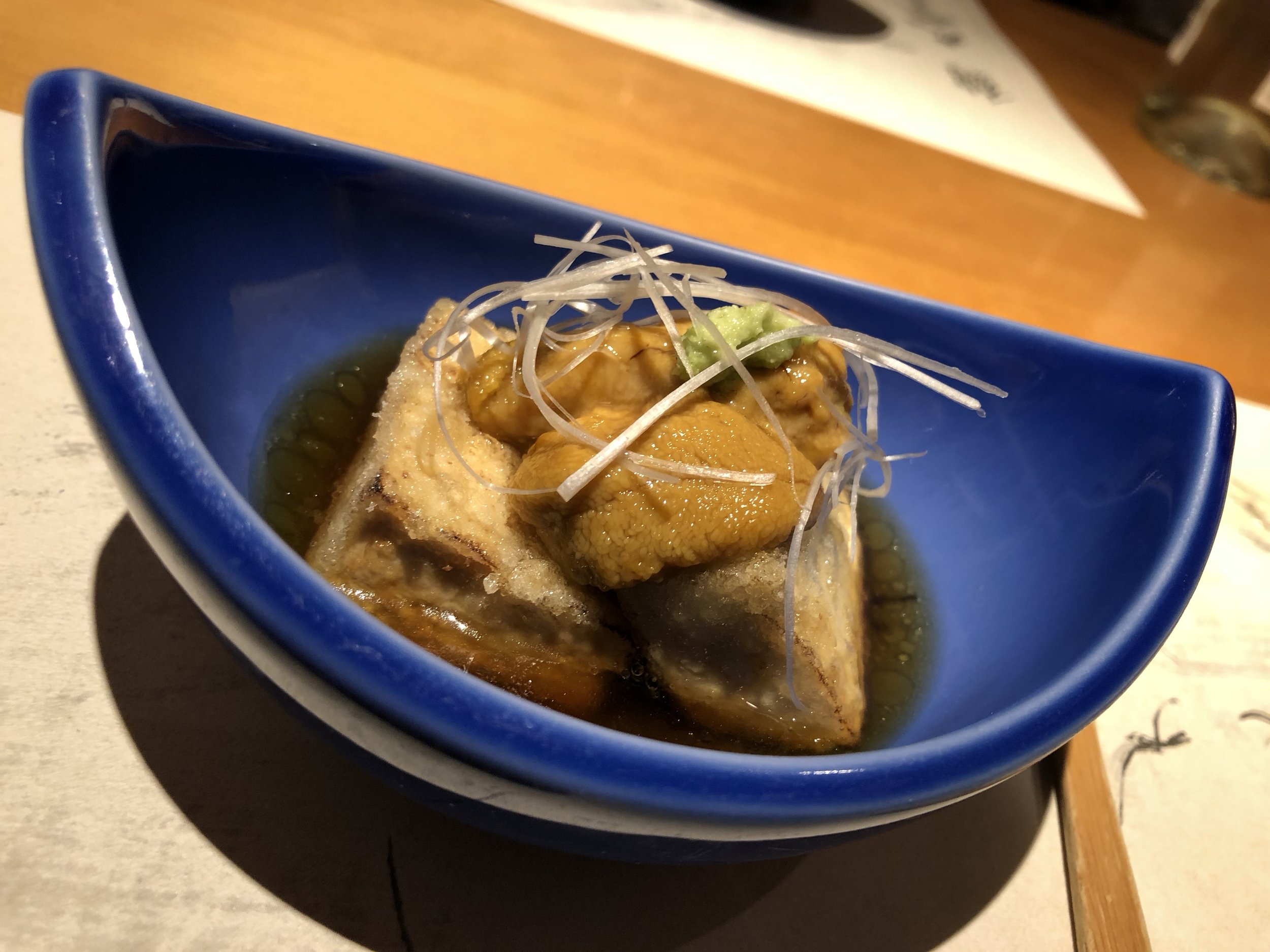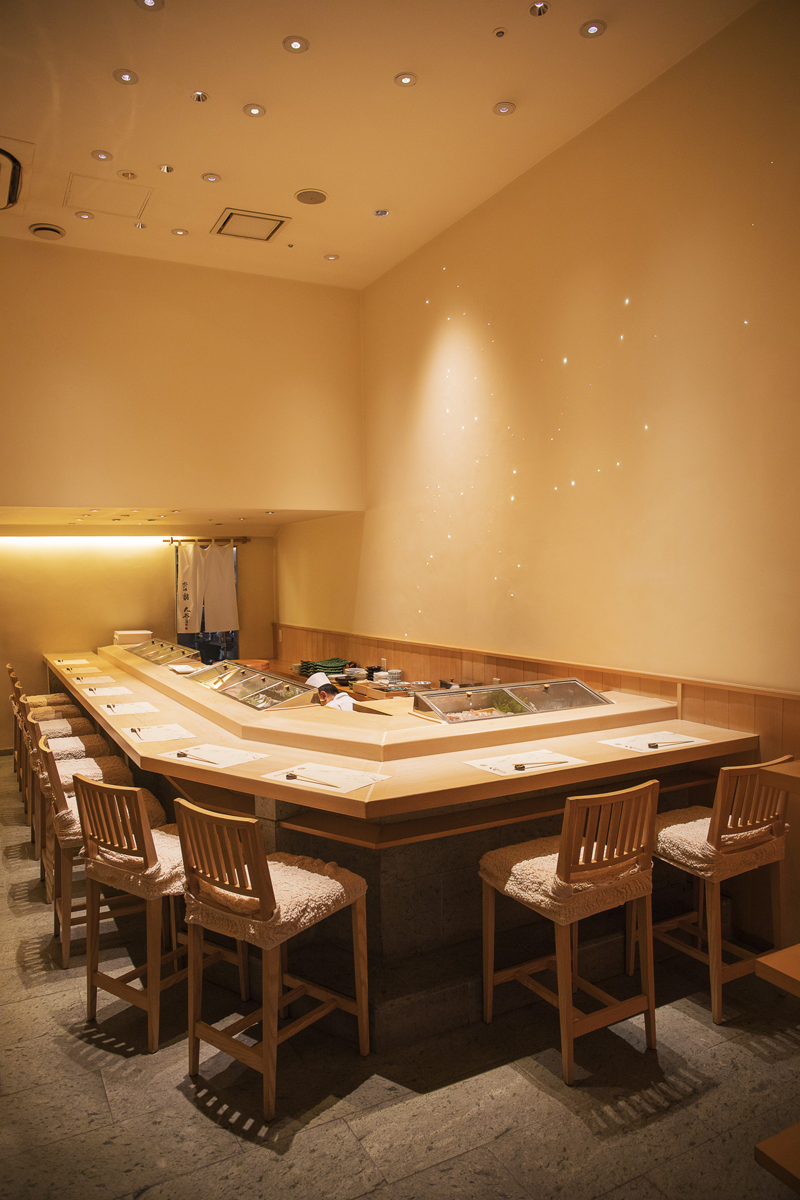Ben Greenfield in Tokyo #1
We stopped by a cafe where can have a cap of high quality coffee
Guess who I was with in Tokyo Japan? I spent a week with Ben Greenfield, who is a New York Times Bestselling author, speaker and coach. You can find out who he is on his website and it would be much easier because I cannot explain about everything of his profile. Anyway though, it was my honor to spend time with him because I am a huge fan of him and his podcast. He is definately one of top influencers in fitness, health and wellness industories. Ben came to Tokyo for private speaking, however asked me for showing around while he stays in Tokyo, so I flied from Boston to Tokyo. Of course, my family was so surprised at me at home for a short while. Those who follow Ben’s SNS may know what we had been doing in Tokyo, but I would love to share our amazing experience in Tokyo with you guys.
DAY1
I and Ben took a homemade miso workshop by Noda Miso Co on the first day. Ben is not a regular turist, but an adventurous person who is looking for true experience. I coordinated Miso making experience with a traditional craftman from 80 years old Miso company in Aichi prefecture.
Miso is made from fermented soybeans and is a thick paste-like substance. It doesn't sound particularly delicious, but it has a great umami flavor. Like most fermented foods, miso improves the balance of good flora in the digestive tract. But the benefits don’t stop there. Miso is chock full of minerals, can lower the risk of breast cancer and is very high in antioxidants too. Plus, it lends amazing flavor to just about any stock or soup. It's an essential ingredient for many Japanese food, including miso soup.
Types of Miso
We started with miso tasting before making homemade miso. We found miso described by its color or ingredients, such as "red miso", "white miso", or "barley miso". Those new to Miso are often surprised to learn that there are near- infinite types, just as there are countless varieties of wines or cheeses. If you adjust the ratio of soy to grain to salt, the environment, the length of fermentation, or the grains chosen, a different type of miso results.
Kome miso is the most common type in Japan, making up more than 80% of the miso produced. It is made from rice, soybeans & a bacterial culture & then mashed. Salt is added and the mixture is left to ferment for 6-12 months. Broadly speaking a six-month rice miso is called “shiro miso” ( white miso) and a twelve-month rice miso is called “aka miso” (red miso). White miso is milder in flavour, with gentle sweet & salty tones, while red miso has a much sharper tang with a far more pungent aftertaste.
Mame miso uses a rice malt and tends to be dark brown with a rich taste.
Barley Miso (Mugi Miso) is the rustic, less polished cousin of rice miso. Usually darker in color and a bit chunky in texture, it is made from soybeans, barley koji and salt, and is sometimes called “country miso”. Typically those living in the southern parts of Japan – Honshu and the islands of Kyushu & Shikoku – prefer this type of miso. Most barley miso is aged for longer than rice miso; the mixture is higher in protein and lower in carbohydrates, so it is not as sweet & takes longer to ferment.which is very flavorful, very salty, and "full-bodied."
Shiro miso is common in the United States and is also sometimes called white miso. It's a bit less salty and made with both soybeans and rice.
Basic of Miso-Types of Miso
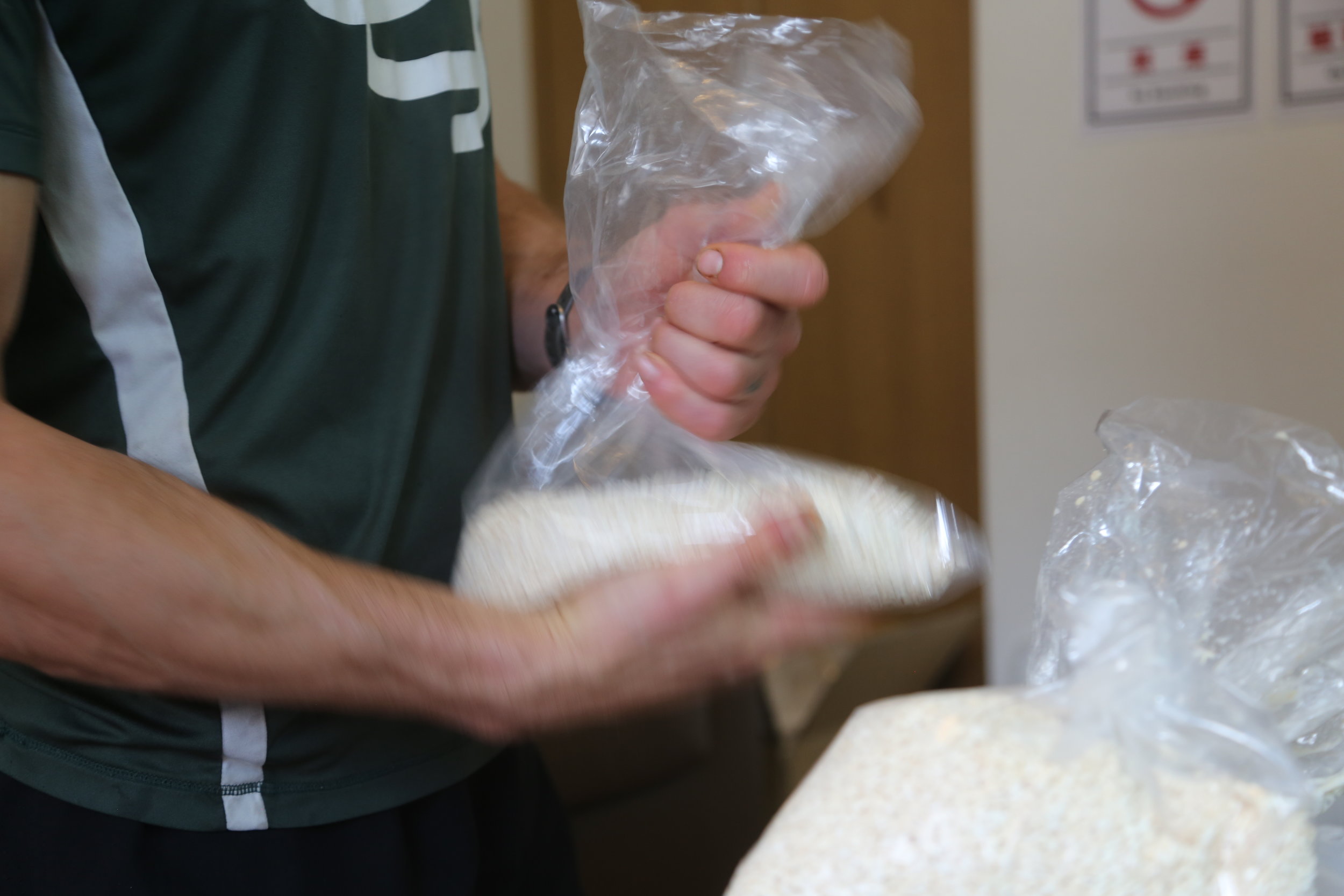
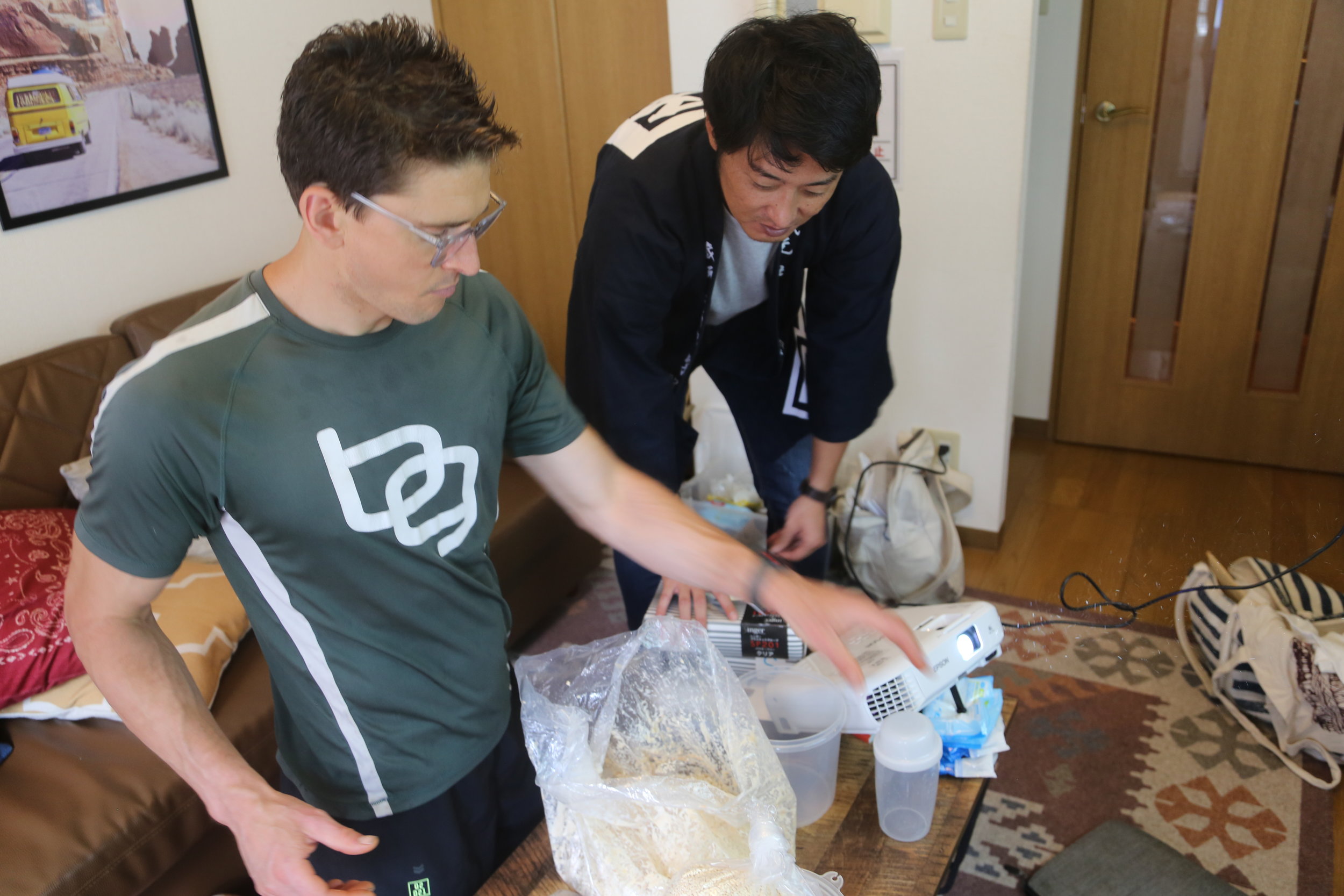
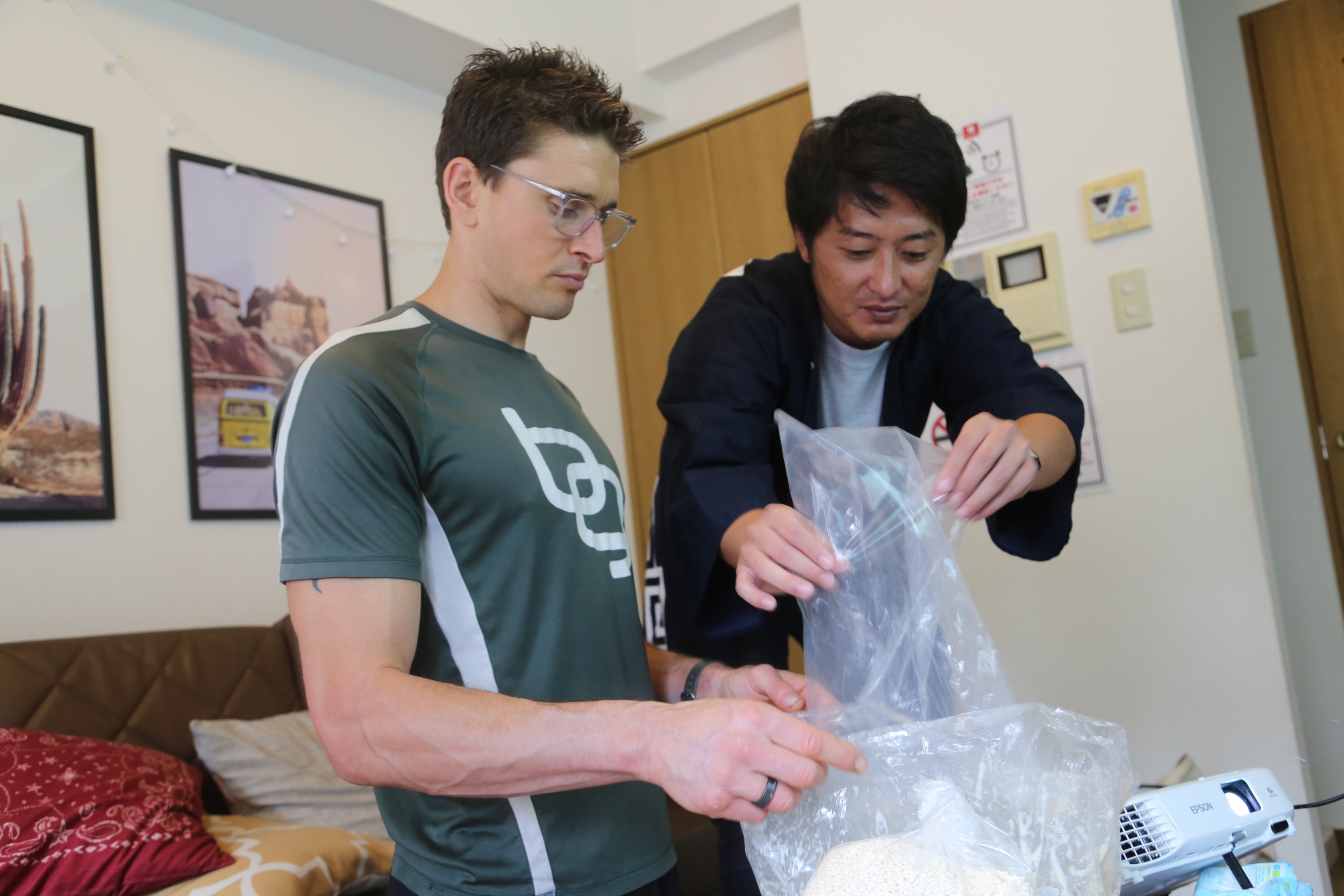
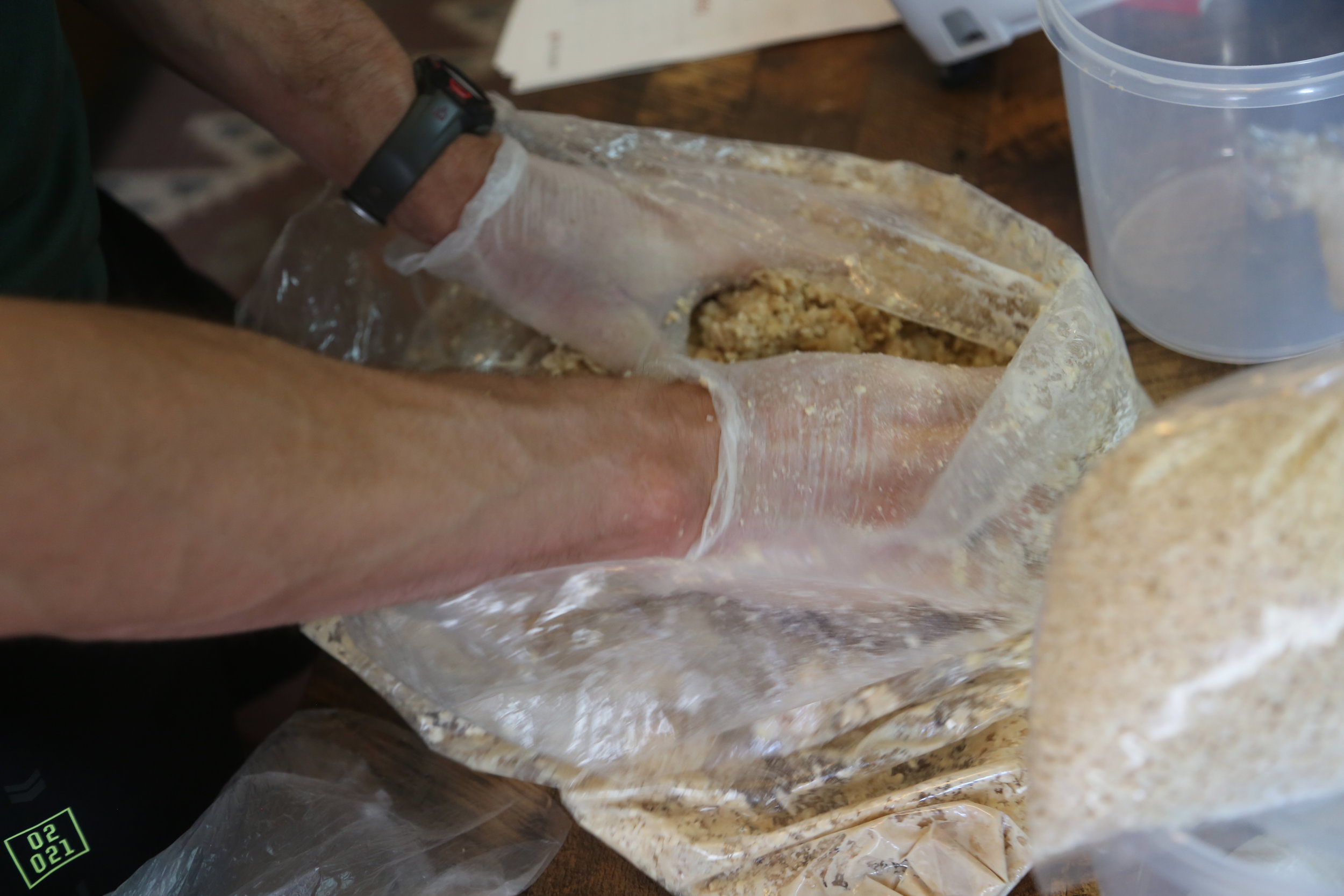
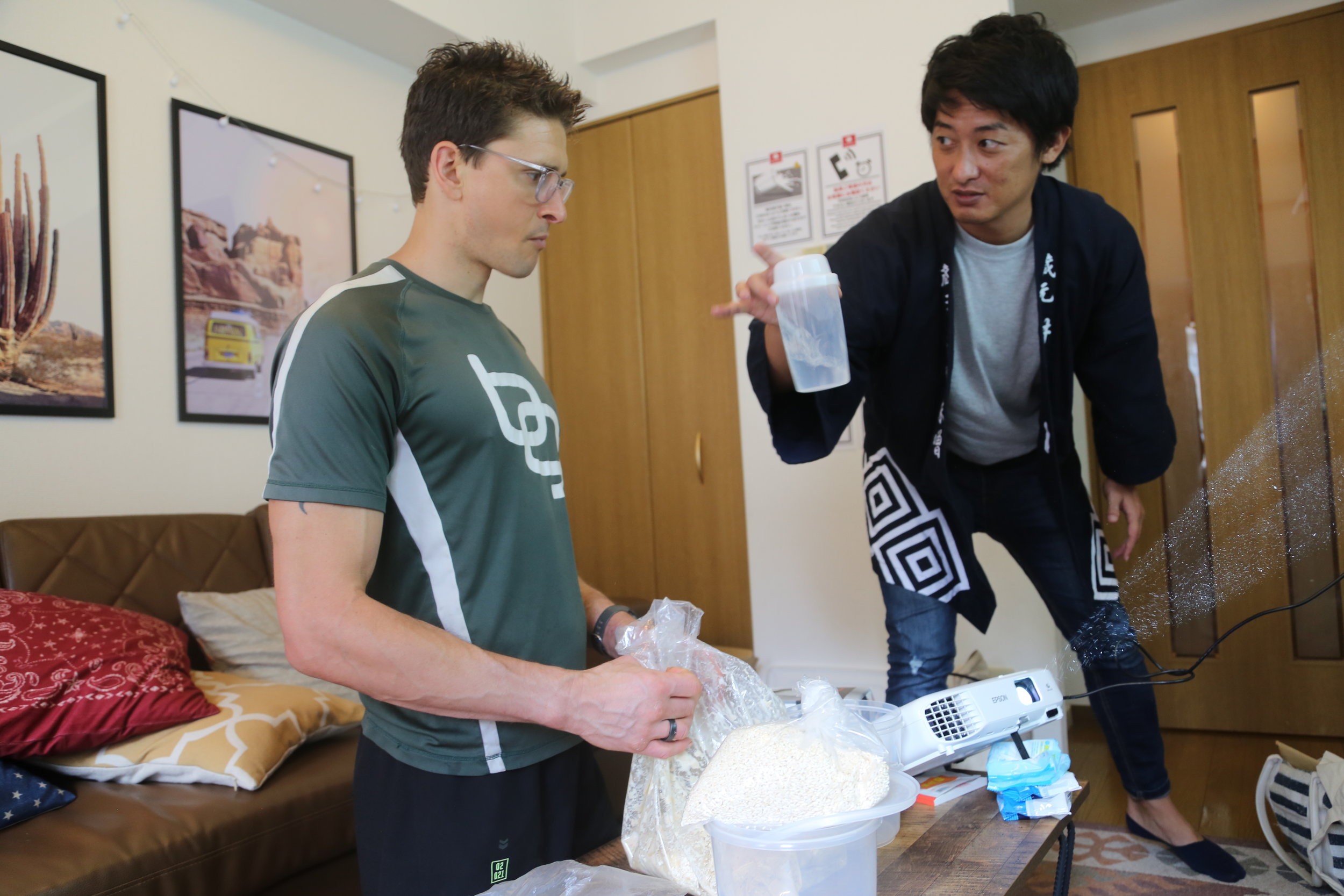
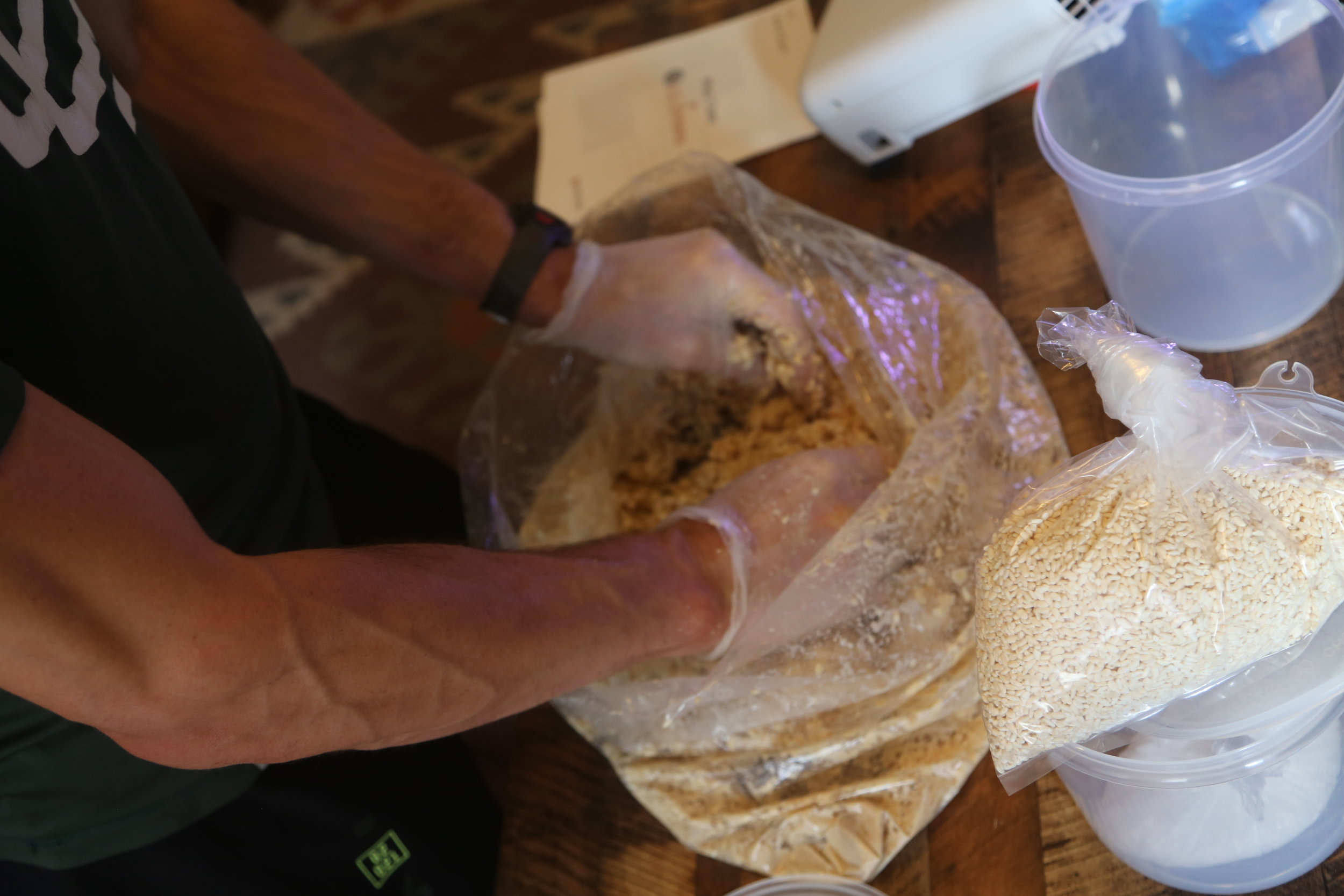
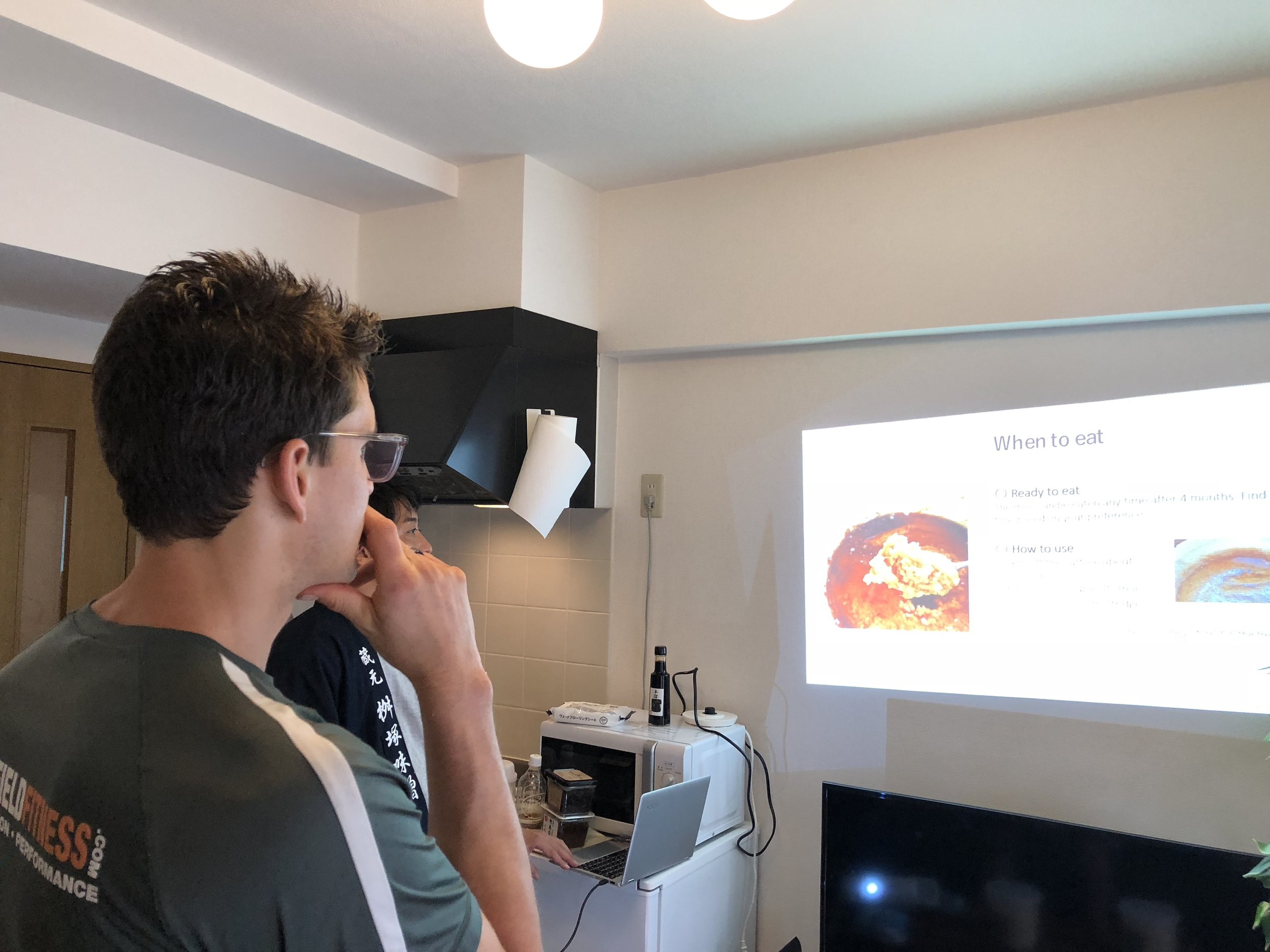
Basic of Miso
Fermentation
How to ferment
Natural fermentation (10%)> a traditional method that allows the miso to mature naturally according to the chnging climate conditions of the four seasons.
Temperature controlled fermentation (90%)> artificially controlled temperature and humidity to mature miso in a much shorter period of time.
Where to ferment
Wooden Barrel (5%) miso is produced in large, aged-wooden barrels and good yeasts are living inside of the wooden tubs and play an important role in fermenting the miso. These types of barrels are some of the best tools for producing full bodied mellow rice miso. The four seasons also aid the miso's aging process. Long-term aging mellows the miso and gives it a rich aroma and flavor. It also contains living lactic acid bacilli, which plays an important role in intestinal health.
Stainless steel or other material barrel (95%) Unfortunately, only less than 5% of the miso is made by traditional methods. Most miso is mass-produced in a factory using additives and heat to speed up fermentation so that a batch can be finished in 2-3 months. But, this “quick made miso” doesn’t have enough time to build up the complex flavors that you would get through natural, slow fermentation, so more additives and chemicals are added to attempt to make up for the loss of flavor.(As you can see some miso pastes are MSG added at Asian grocery in US) After tasting Noda’s miso or other traditional miso, you’ll definitely notice the difference whenever you eat miso made through mass-production processes.
I want to show my gear. This Onnit division daypack is a perfect upgrade for my life! I use it while hiking and hillclimbing. This pack fits on my body well and passed my expectations as well. It has so many pockets and is very well designed and put together. I love how much I can pack in this backpack.
Kome miso making process
Above chart explains how mass produce miso is processed. I and Ben did a traiditional handmade miso making process. Here is our recipe down below.
Kome Miso (10wari) 1.85kg Ingredients
Boiled soybean 1kg (in case of raw soybean: 500g)
Kome Koji 500g
Salt 200g
Water150cc
Smash! (Crush soybneans & rice koji)
1. Placing the plastic bag on the flat table and smash soybeans by hands.
2.Crush as much as possible.
Ben is smashing soybeans
3. Put rice koji and salt into the plastic bag and mix them well.
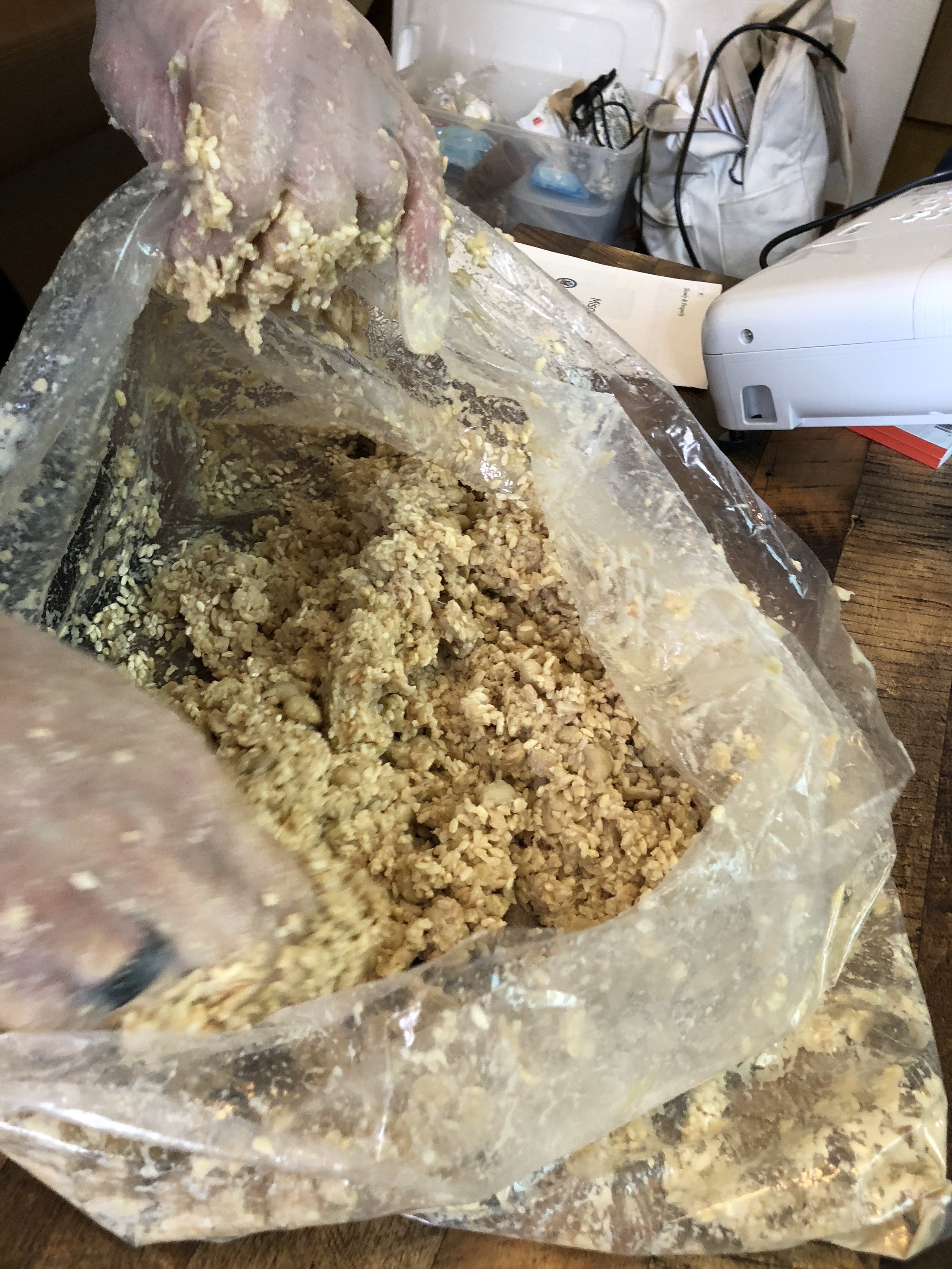
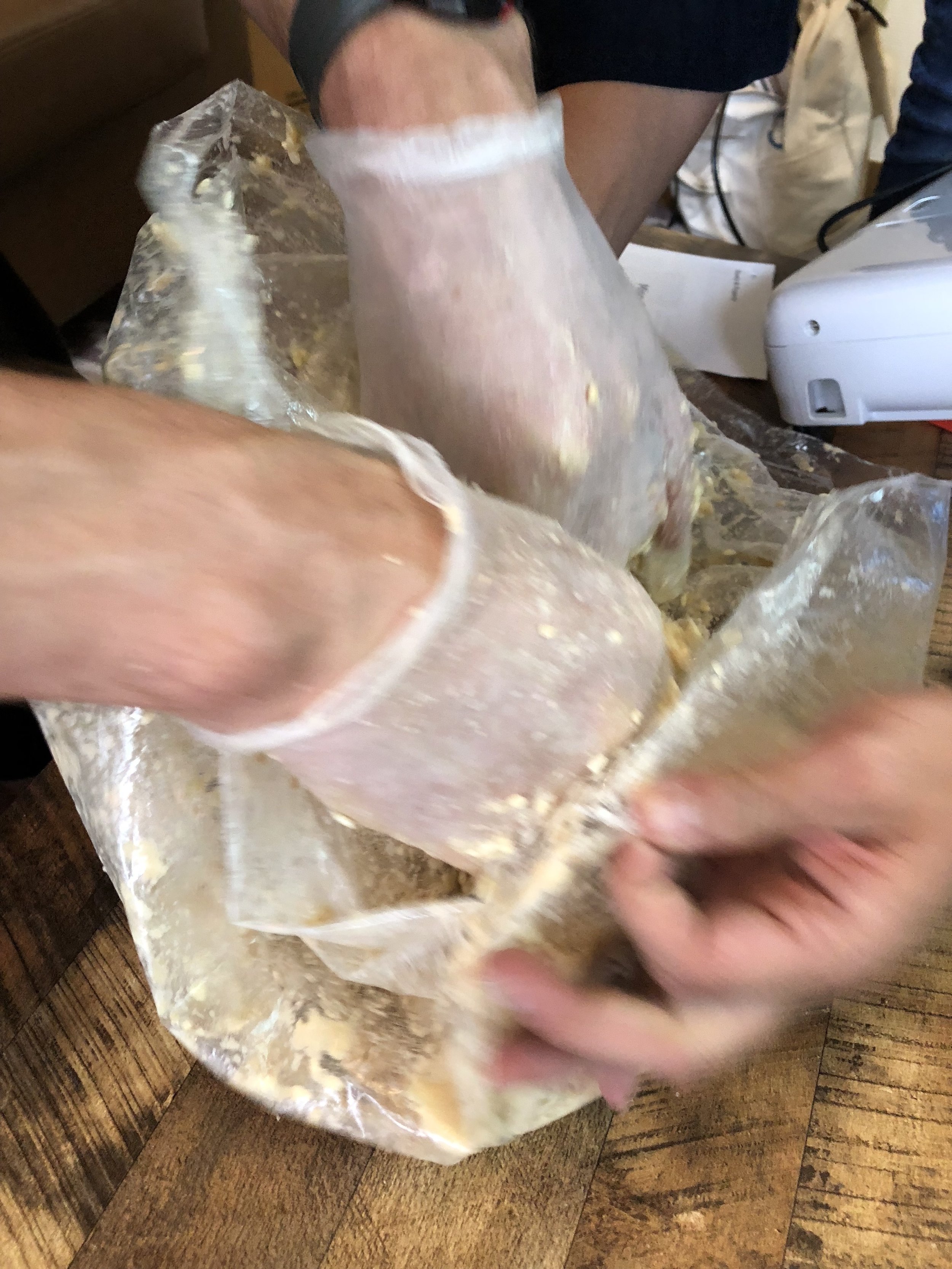
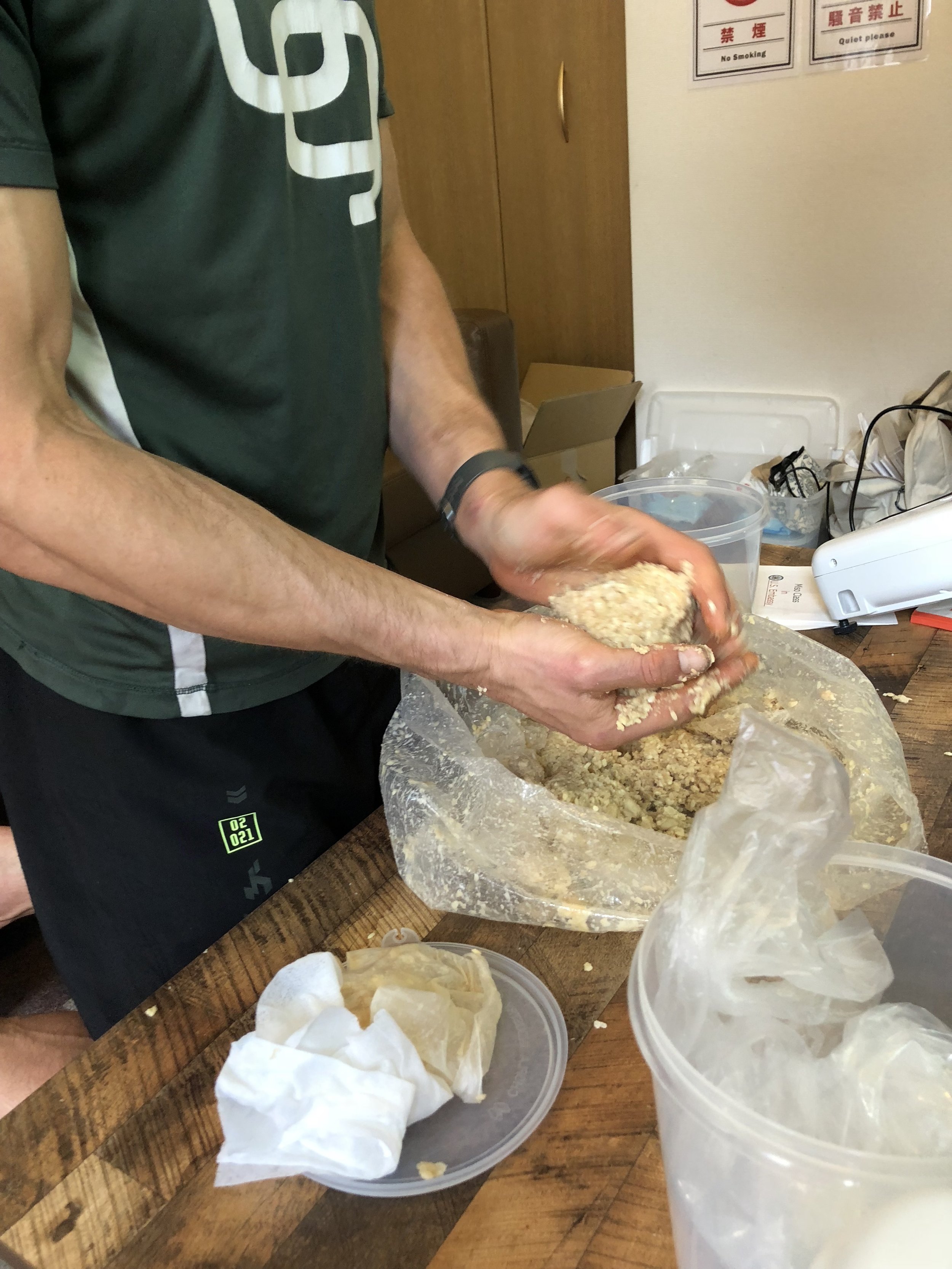
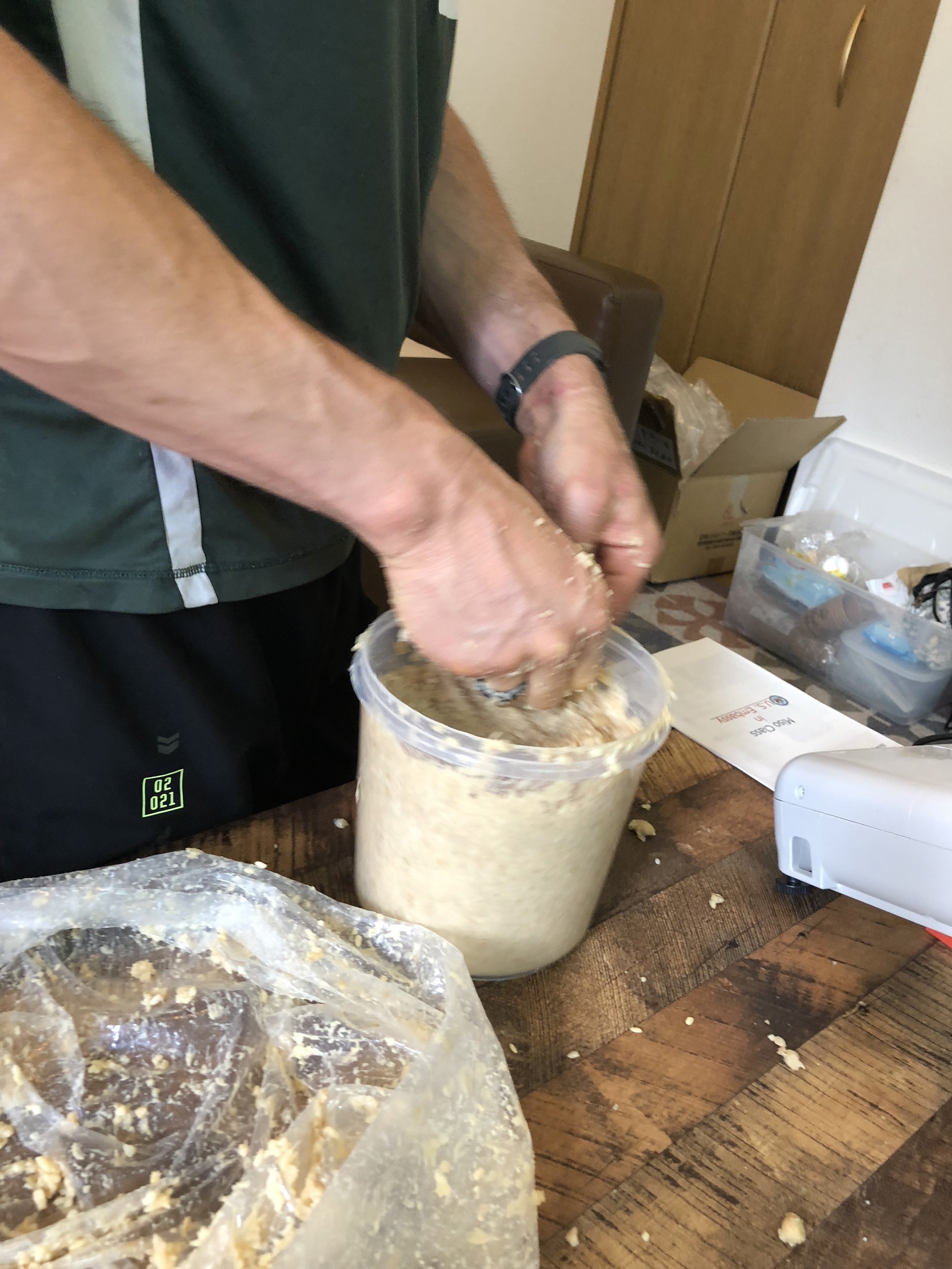
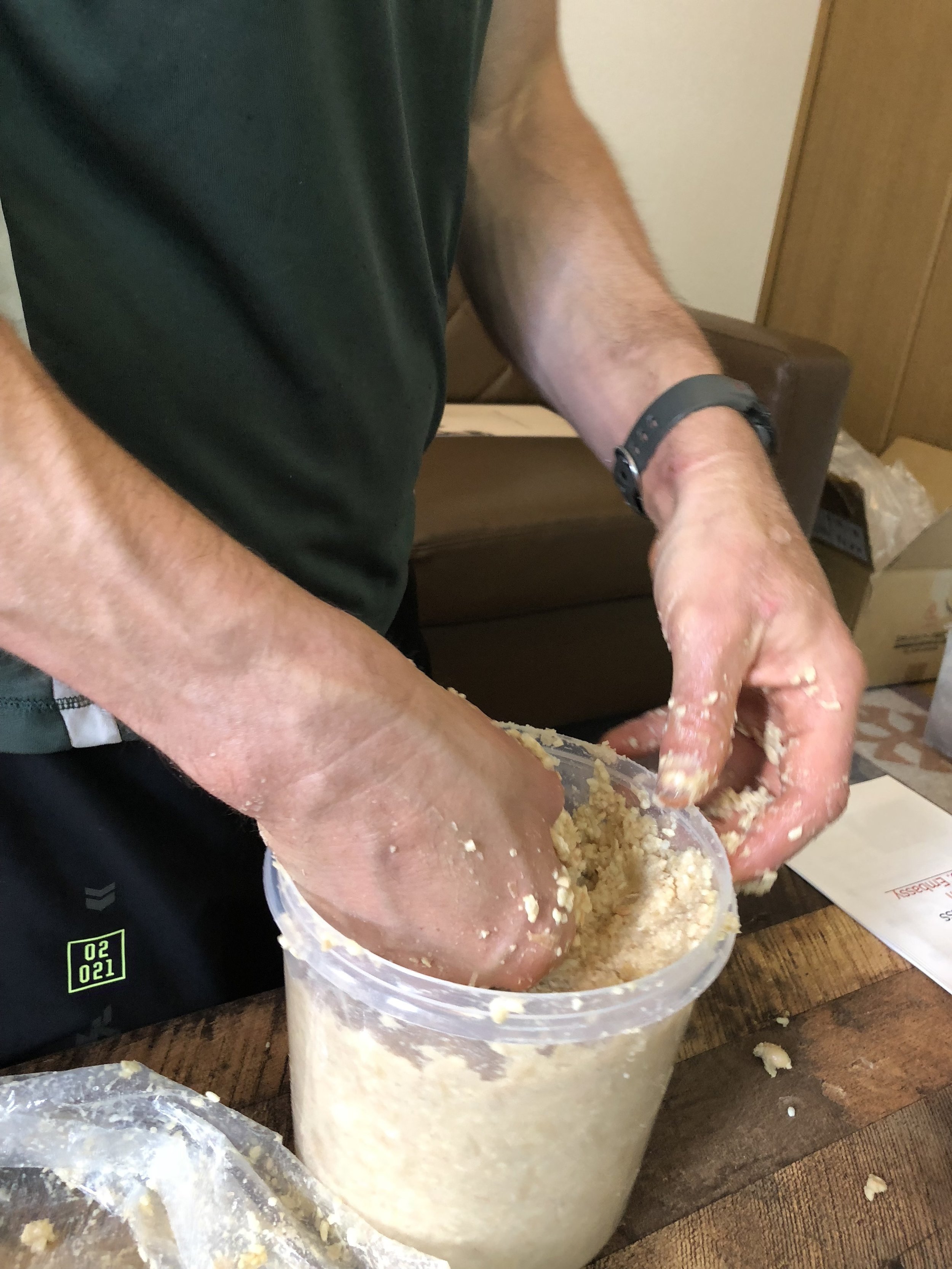
Blend & Fill into your own strage
4. Place the mashed soybean and blended kome koji into a large tray with water.
5. Mix them well
6. Make a miso ball. *rather squeeze while forming miso ball to make sure no air inside
7. Throw miso ball into the bottom of the container with some force to knock out any air in the balls.
8. Fill the container with the balls and press properly.
Covering up! This is my miso
9. Flatten the surface.
10. Sprinkle salt across the surface on the top, particularly around the edges. *salt prevents unnecessary mold from growing.
11.Cover with cloth or cling film.
12. Secure with the lid. Place heavy weight on the top, which is about 20-30% weight of the miso. *place a hard-flat material under the weight to give pressure equally.
*cover with newspaper or cloth if you want to keep dust away.
Ben & Miso Master Yoshi in Tokyo
Place
Keep in cool place away from direct sunlight
Mold
White mold can be glown on the surface during the fermentation, which is natural and no harm on human body. Leave it until the miso perfected, or skim off gently if you concern. However, if the color of the mold is rather colorful, like dark or blackish color, scrap it deeply ASAP and scatter plenty of salt on the affected area.
wait for 4 month…
Ready to eat
Miso will be ready to eat any time after 4 months. Find the best time on your preference. Mine will be ready in middle of January 2019. I can’t wait!
How to use
Skim off the surface about 5mm-1cm, and replace in a couple of small containers to fit in the fridge,
If you want miso to stop fermentating completely, store it in the freezer.
I took Ben to Ginza where it is a neighborhood esteemed by everyone in Japan. It's a place where you can find the best fashion, gourmet, beauty, and other luxurious ways to spend your time. What did we have for dinner? Of course, Sushi! The Edo style sushi was a product of the booming Edo culture when more and more commoners were allowed to hold businesses of their own. Tokyo used to be Edo during samurai era (before westenized), so I wanted Ben to have truly authentic sushi in Tokyo.
We visited Kutani in Ginza Tokyo. In Kutani they serve the highest grade of qualitys eafood freshly caught for the day from Raus-cho, Hokkaido transported by Air. What makes Kutani special? They serve red rice! Rice is by far the single most important element of sushi. Procuring and preparing good quality seafood doesn't matter much if the rice is not good. Sushi chefs are judged first and foremost on the quality, attributes, and taste of their rice. Akazu (also called kasuzu ) vinegar is made using sake lees (sake kasu ) which is the yeast slurry left over from sake production. It is considered by many to be the vinegar of choice for traditional Edomae-zushi. Rice vinegar was expensive during the Edo period so aka-zu was used as a cheaper, delicious alternative.
Aka-zu is typically aged for three to five years, so ironically these days it is more expensive to produce than rice vinegar. Its reddish-black color (see image below) darkens the sushi-rice - the more akazu is used, the darker the rice will appear.
Akazu is a critical component of Edomae-zushi. It brings a deep, flavorful, refreshing taste full of umami to sushi rice. I know Ben is very particular about food he put in his mouth. Seafoods must from wild caught and radiation free. Hokkaido is very famous about fresh seafood. Also, fishmarkets are usualy closed on Wednesday and Sunday, so I wanted Ben to have a fresh sushi at Friday night. I think Kutani gave us a great experience.
Sushi Kutani
7-3-9 Ginza, Chuo-ku, Tokyo 104-0061 Ginza Lee Building B1F (along the Outer Boru Territory)
TEL.03-3573-8030
【Business Hours】
* Business hours will be changed to 17:30 ~ 4:00(next morning) starting on November 1st, 2018.
Monday through Saturday
Dinner 17:30~4:00(Last entry 3:00)
【Close】
Sunday and national holiday
Kutani, Ginza, Tokyo
-
Biohacking
14
- Oct 31, 2019 Upgraded Dinner Helsinki 2019
- Nov 4, 2019 First time in Lapland
- Nov 5, 2019 Helsinki 2019
- Nov 6, 2019 Short Stay in London
- Jun 30, 2024 Optimized Day Workshop Helsinki 2024
- Jul 1, 2024 Upgraded Dinner Helsinki 2024
- Jul 4, 2024 Biohacker Summit Helsinki 2024: A Landmark Event with Team Japan
- Jul 6, 2024 Upgraded Offsite Samurai Island Helsinki 2024
- Jun 11, 2025 HOLOLIFE VIKING ACADEMY - RETREAT EXPERIENCE
- Jun 13, 2025 HOLOLIFE DINNER - VIP EXPERIENCE
- Jun 15, 2025 The Longevity Goldrush: A Recap of the HOLOLIFE Summit 2025
- Jun 17, 2025 The War Council for Wellness: HOLOLIFE Mastermind
- Oct 9, 2025 HOLOLIFE DINNER Tokyo 2025
- Oct 12, 2025 HOLOLIFE Summit Tokyo 2025
-
Event
4
- Aug 20, 2025 Mindvalley in Amsterdam 2025
- Oct 9, 2025 HOLOLIFE DINNER Tokyo 2025
- Oct 12, 2025 HOLOLIFE Summit Tokyo 2025
- Oct 15, 2025 Morning in a 1000-Year-Old Onsen, Evening Watching a Monk Beatbox on Bikes
-
Gourmet
2
- Jul 28, 2019 TIME OUT Market Boston
- Jul 1, 2024 Upgraded Dinner Helsinki 2024
-
Japan
6
- Sep 7, 2018 Ben Greenfield in Tokyo #1
- Sep 9, 2018 Ben Greenfield in Tokyo #2
- Sep 10, 2018 Ben Greenfield in Tokyo #3
- Sep 11, 2018 Ben Greenfield in Tokyo #4
- Oct 16, 2025 From 1000-Year-Old Silk to the Cheapest Ramen in Tokyo - One Perfect Day
- Oct 20, 2025 百薬: Where 1000-Year-Old Fermentation Meets Gratitude - My Post-Summit Celebration
-
MMA
1
- Oct 19, 2019 UFC Boston
-
Private
41
- Aug 27, 2018 Unplugged
- Sep 7, 2018 Ben Greenfield in Tokyo #1
- Sep 9, 2018 Ben Greenfield in Tokyo #2
- Sep 10, 2018 Ben Greenfield in Tokyo #3
- Sep 11, 2018 Ben Greenfield in Tokyo #4
- Feb 27, 2019 Kamakura Boston
- Apr 26, 2019 Gala Dinner of The Japan Society of Boston
- Apr 27, 2019 MAPS 2019 Awards Gala
- Jun 1, 2019 15 Years
- Jun 16, 2019 Hideru in Boston
- Jul 28, 2019 TIME OUT Market Boston
- Aug 4, 2019 Boston Skyline Views
- Aug 11, 2019 Tanglewood Boston Symphony Orchestra 2019
- Aug 18, 2019 Unplugged 2019
- Nov 4, 2020 Welcome to the world “Lumi”
- Oct 18, 2021 Back to Japan after 3 years
- May 3, 2022 A Biohacker's Journey: Exploring Estonia and Virtual Realities
- Jun 1, 2022 Optimized Day Workshop Helsinki 2022
- Jun 2, 2022 Upgraded Dinner Helsinki 2022
- Jun 5, 2022 Upgraded Offsite Helsinki 2022
- Jun 26, 2022 My Journey with Kyle Bochniak
- Aug 22, 2022 A Summer of Music and Memories
- Sep 19, 2022 Welcome to the world “Lui”
- Oct 12, 2022 Optimized Day Workshop Amsterdam 2022
- Oct 14, 2022 Upgraded Dinner Amsterdam 2022
- Oct 17, 2022 A Biohacker's Journey: Amsterdam 2022
- Dec 19, 2022 Exploring Biohacking in Japan
- Mar 19, 2023 SXSW 2023
- May 14, 2023 Recharging in Nature after a Biohacking Retreat
- Aug 26, 2023 Zen Musicianship Transcends Boundaries in France
- Aug 29, 2023 Blending Work and Family in France
- Sep 3, 2023 An Ancestral Journey: Biohacker Summit London After Party
- Oct 24, 2023 Optimized Day Workshop Amsterdam 2023
- Oct 26, 2023 Upgraded Dinner Amsterdam 2023
- Nov 4, 2023 A Biohacker's Chronicle: Amsterdam 2023
- Apr 28, 2024 Japan Festival Boston 2024
- May 10, 2024 Vero in Boston
- Jul 10, 2024 Blending Work and Family in Nordic
- Jul 1, 2025 From Tallinn to Helsinki: When Your Family Becomes Your Greatest Teacher
- Oct 16, 2025 From 1000-Year-Old Silk to the Cheapest Ramen in Tokyo - One Perfect Day
- Oct 20, 2025 百薬: Where 1000-Year-Old Fermentation Meets Gratitude - My Post-Summit Celebration
-
Rio
15
- Jul 26, 2015 Rio 1 -Rescued a wild bird-
- Aug 2, 2015 Rio 2 -Fledge?-
- Sep 17, 2015 Rio 3 -Showering Flying Surfing-
- Oct 24, 2015 Rio 4 -Pecking everything-
- Dec 27, 2015 Rio 5 -Lazy Sunday-
- Mar 3, 2016 Rio 6 -Like a Cat-
- Apr 6, 2016 Rio 7 -Dust bath on my head-
- May 19, 2016 Rio 8 -Deep Sleep-
- May 29, 2016 Rio 9 -Nail Salon by Tateki-
- Jul 5, 2016 Rio 10 -Reading with Rio-
- Sep 25, 2016 Rio 11 -Life with Rio-
- Nov 17, 2016 Rio 12 -Cage Free-
- Nov 27, 2016 Rio 13 -Recovery Day-
- Apr 21, 2017 Rio 14 -Hot and Cold-
- Jul 17, 2019 Rio got a brother? or Sister?
-
Sketch
2
- Dec 19, 2016 What to sketch -do it now, think later-
- Apr 23, 2017 Sketch Now Think Later
-
Travel
19
- Nov 5, 2019 Helsinki 2019
- Nov 6, 2019 Short Stay in London
- Jan 29, 2020 Barcelona 2020 Day1
- Jan 30, 2020 Barcelona 2020 Day2
- Jan 31, 2020 Barcelona 2020 Day3
- Feb 1, 2020 Barcelona 2020 Day4
- Feb 2, 2020 Barcelona 2020 Day5
- Feb 3, 2020 Barcelona 2020 Day6
- Feb 4, 2020 Barcelona 2020 Day7
- Mar 18, 2024 SXSW2024
- Apr 7, 2024 Biohacker’s Retreat 2024 Recap
- Jul 6, 2024 Upgraded Offsite Samurai Island Helsinki 2024
- Jul 10, 2024 Blending Work and Family in Nordic
- Jul 21, 2024 Cezch Republic 2024
- Jul 1, 2025 From Tallinn to Helsinki: When Your Family Becomes Your Greatest Teacher
- Aug 20, 2025 Mindvalley in Amsterdam 2025
- Oct 14, 2025 Nozawa Onsen - The Perfect Recovery After Tokyo Summit
- Oct 15, 2025 Morning in a 1000-Year-Old Onsen, Evening Watching a Monk Beatbox on Bikes
- Oct 20, 2025 百薬: Where 1000-Year-Old Fermentation Meets Gratitude - My Post-Summit Celebration
-
Japan
1
- Dec 9, 2022 Biohacker Center meets Japanese “Mr. Internet“
-
NEWS
77
- Aug 31, 2014 Traveled a Unique Path to UFC Debut at Fight Night 50
- Sep 7, 2014 UFC Fight Night 50 Sponsorship
- Nov 24, 2014 UFC Fight Night 59 in Boston
- Jan 19, 2015 UFC Fight Night 59 Sponsorship
- Sep 1, 2015 Muay Thai Program at Fenix BJJ
- Oct 24, 2015 Fight Announcement
- Dec 28, 2015 Thanks for Support in 2015
- Jan 1, 2016 Happy New Year 2016
- Jan 8, 2016 Legacy Fighting Championship 51
- Jan 18, 2016 Tateki's Fighting Expedition
- Jan 23, 2016 The Total Human Optimization
- Feb 6, 2016 Legacy 51
- Jul 29, 2016 Fight Announcement Pancrase 280
- Sep 11, 2016 Pancrase 280
- Nov 13, 2016 Cats out of the "pads" !
- Dec 26, 2016 Let's Burn Off
- Jan 30, 2017 Fight Announcement Pancrase 285
- Mar 13, 2017 Pancrase 285
- Sep 11, 2017 Shoulder surgery
- Sep 19, 2017 How to Achieve a Lifetime of Sustained Peak Performance
- Apr 17, 2018 Own the Day, Own Your Life
- May 8, 2018 Fight Announcement Pancrase 297
- Jul 2, 2018 Pancrase 297
- Sep 8, 2018 TB12 VIBRATING PLIABILITY ROLLER
- Oct 6, 2018 Lessons
- Jan 1, 2019 Fight Announcement CES 54
- Jan 20, 2019 CES 54
- Mar 30, 2019 TECH by Champion
- Jun 23, 2019 Fight Announcement CES 57
- Jul 27, 2019 CES 57
- Aug 16, 2019 TB12 Vibrating Pliability Sphere
- Sep 17, 2019 Red Carpet at the TB12 Boston opening party
- Nov 6, 2019 Partnership with Biohacker Center BHC Inc
- Jan 1, 2020 Fight Announcement Cage Titans XLVII
- Jan 26, 2020 Cage Titans 47
- Apr 30, 2020 Be healthy with Vessi
- Jul 20, 2020 TB12 Vibrating Pliability Mini Sphere
- Mar 17, 2021 Tsurumen Inc
- May 13, 2021 The manufacture of San J in Virginia
- Nov 30, 2021 Corporate wellness Program in Japan
- Dec 13, 2021 Biohacker Center Japan Press Release
- Feb 5, 2022 GF Ramen is available at Tsurumen
- Mar 19, 2022 XMMA fight announcement
- Apr 3, 2022 XMMA4
- Apr 10, 2022 Biohacker’s Retreat 2022
- May 21, 2022 Speaking at Biohacker Summit in Helsinki
- Jun 7, 2022 Biohacker Summit Helsinki 2022
- Jun 26, 2022 Monthly Article by Tateki on Hakkohub
- Jul 9, 2022 Bankless Monk
- Aug 18, 2022 Speaking at Biohacker Summit in Amsterdam
- Oct 19, 2022 Biohacker Summit Amsterdam 2022
- Dec 9, 2022 Biohacker Center meets Japanese “Mr. Internet“
- Mar 19, 2023 Bankless Monk at SXSW 2023
- Apr 28, 2023 Biohacker’s Retreat in Estonia 2023
- Aug 16, 2023 Warm up event in London
- Aug 20, 2023 GF Ramen Lab Noodles Now Available on Amazon
- Sep 6, 2023 Biohacker Summit 2023 London
- Oct 1, 2023 Unlocking Movement's Mysteries at the Biohacker Summit
- Nov 5, 2023 Biohacker Summit Amsterdam 2023 Recap
- Feb 20, 2024 Corrective Exercise with Tateki Matsuda
- Feb 27, 2024 MeltingPot Forum 2024
- Mar 15, 2024 Biohacker’s Retreat 2024
- Mar 18, 2024 Bankless Monk at SXSW 2024
- Apr 20, 2024 The 65th Anniversary of Boston-Kyoto Sister City
- May 30, 2024 BBETTER Podcast Episode 98: Corrective exercises with Tateki Matsuda
- Jun 1, 2024 Biohacker Summit Helsinki 2024
- Jul 5, 2024 Biohacker Summit Helsinki 2024 Recap
- Jul 19, 2024 Colours of Ostrava 2024
- Aug 12, 2024 Biohacker Summit Tokyo Postponed to October 2025
- Sep 6, 2024 Creative Refresh Retreat in Sri Lanka
- Apr 28, 2025 Dave Asprey’s Biohacking Conference 2025 | Mind-Body Optimization in Austin
- May 8, 2025 HOLOLIFE Summit 2025: Longevity, Wellness & Transformation in Estonia
- Jun 20, 2025 HOLOLIFE Summit Tallinn 2025 Recap
- Aug 31, 2025 Bridging Ancient Wisdom and Future Science at HOLOLIFE SUMMIT 2025
- Sep 12, 2025 Kokorozashi: My Documentary Film Reveals the Japanese Philosophy
- Oct 9, 2025 Dual Mission: Bringing HOLOLIFE Summit to Tokyo While Advancing Women's Health Equity
- Oct 12, 2025 The Zen of Longevity Realized: HOLOLIFE Summit Tokyo 2025 Transforms Global Wellness
-
Private
4
- Dec 31, 2018 Keep Going
- Jan 1, 2020 Thanks 2019 & Happy New Year 2020
- Jan 1, 2021 Thanks 2020 & Happy New Year 2021
- Jan 1, 2022 Thanks 2021 & Happy New Year 2022
-
Biohacking
15
- Jun 4, 2018 Mushroom Coffee
- Aug 1, 2018 keto box
- Mar 17, 2019 Keto Mojo
- Nov 2, 2019 Biohacker Summit Helsinki 2019
- Jun 4, 2022 Biohacker Summit Helsinki 2022
- Oct 16, 2022 Biohacker Summit Amsterdam 2022
- May 1, 2023 Biohacker’s Retreat April 2023
- Sep 4, 2023 Biohacker Summit London 2023 Show notes
- Sep 18, 2023 Biohacker’s Retreat September 2023
- Oct 29, 2023 Biohacker Summit Amsterdam 2023 Show Notes
- Apr 10, 2024 Biohacker’s Retreat in IBIZA 2024
- Jul 3, 2024 Biohacker Summit Helsinki 2024
- Jul 20, 2024 Meltingpot Forum 2024
- Jun 5, 2025 Biohacking Conference 2025
- Dec 10, 2025 Japanese Chrono Trigger: Rethinking Time and Longevity
-
Coffee
2
- Jun 4, 2018 Mushroom Coffee
- Aug 1, 2018 keto box
-
Earthing
1
- Jun 7, 2019 Earth Runner
-
Gut health
1
- Jul 2, 2019 Viome
-
Injury
8
- Sep 11, 2017 Determination
- Sep 29, 2017 Week 3
- Oct 6, 2017 Week 4
- Oct 13, 2017 Week 5
- Oct 30, 2017 Week 6 & 7
- Nov 13, 2017 Week 8 & 9
- Nov 26, 2017 Week 10 & 11
- Dec 30, 2017 After Week 12
-
Nutrition
10
- Jun 4, 2018 Mushroom Coffee
- Aug 1, 2018 keto box
- Jun 26, 2022 Fermented Foods for Health Optimization
- Aug 10, 2022 Fermented Foods for Immune System
- Oct 2, 2022 Fermented Foods for Healthy Skin
- Nov 7, 2022 Japanese Drinkable IV “Amazake”
- Dec 23, 2022 “Mirin” Sweet Rice Sake Beyond Seasoning
- Jan 29, 2023 Eat “Cultural Heritage.” Osechi Japanese New Year’s Food
- Mar 12, 2023 Fermentation Makes Processed Meat Different
- Apr 13, 2023 Cheese and Your Health: The Impact of Fermentation, Type, and Production Method
-
Performance
3
- Aug 12, 2018 First time Spartan Race
- Aug 14, 2019 Boston Super and Sprint Weekend 2019
- Nov 9, 2019 Spartan race Boston at Fenway Park 2019
-
Recovery
2
- Sep 11, 2016 REhydration Process
- May 15, 2019 BIO CBD plus
-
Rehabilitation
8
- Sep 11, 2017 Determination
- Sep 29, 2017 Week 3
- Oct 6, 2017 Week 4
- Oct 13, 2017 Week 5
- Oct 30, 2017 Week 6 & 7
- Nov 13, 2017 Week 8 & 9
- Nov 26, 2017 Week 10 & 11
- Dec 30, 2017 After Week 12
-
Retreat
3
- May 1, 2023 Biohacker’s Retreat April 2023
- Sep 18, 2023 Biohacker’s Retreat September 2023
- Apr 10, 2024 Biohacker’s Retreat in IBIZA 2024
-
Strength & Conditioning
10
- Jun 20, 2014 MMA Fight Prep 1
- Jun 21, 2014 MMA Fight Prep 2
- Jun 23, 2014 MMA Fight Prep 3
- Jun 23, 2014 MMA Fight Prep 4
- Jun 24, 2014 MMA Fight Prep 5
- Aug 27, 2014 Hit some Swings
- Feb 10, 2015 No Season for MMA Fighters
- Apr 10, 2015 Random Day of my Training
- May 29, 2015 Dropping a Weight Class
- Feb 21, 2016 Conditioning during Fight Week
-
Strong First
1
- Aug 13, 2016 SFG Level 1 Test
-
Supplement
3
- Jun 4, 2018 Mushroom Coffee
- Aug 1, 2018 keto box
- Dec 10, 2018 Complete Nutrition with Bits
-
Tatekitchen
- Nov 2, 2025 thanksgiving 2025
- Feb 14, 2025 Baked Pesto Black Sea Bass
- Jan 31, 2025 Veal with Maitake Cream Sauce
- Jan 1, 2025 Osechi 2025
- Dec 25, 2024 French Cassoulet 2024
- Nov 28, 2024 Thanksgiving 2024
- Nov 2, 2024 Tonkotsu Ramen
- Oct 6, 2024 Pork Chop with New England Apple Sauce
- Sep 27, 2024 Tsukemen: The Dipping Noodle
- Sep 6, 2024 Chicken Paitan Ramen Yeah K style
- Aug 14, 2024 New England Shio Ramen
- Jul 14, 2024 Miso Tanmen
- Jun 20, 2024 Chashu Pork & Chicken Oil: The Secret to Restaurant-Quality GF Ramen at Home
- Jun 16, 2024 The Boston Paella
- May 4, 2024 Beef Tongue Stew
- Apr 25, 2024 Classic Gluten-free chicken shoyu ramen
- Feb 22, 2024 Vegan Gluten-Free Ramen
- Jan 31, 2024 Grilled Artichoke Salad with a sprinkle of reindeer bone broth
- Jan 1, 2024 Osechi 2024
- Dec 25, 2023 French Cassoulet 2023
- Dec 24, 2023 Christmas Eve Duck Breast
- Nov 29, 2023 Thanksgiving 2023
- Sep 24, 2023 Roast Beef Bowl
- Jul 4, 2023 Black Ink Paella
- Jun 17, 2023 Ribeye Steak at a campsite
- May 14, 2023 Biceps Rissoto
- Feb 14, 2023 Chicken Confit
- Jan 31, 2023 Wild Boar with Wagyu Ragù
- Jan 8, 2023 Lobster and Salmon Roe Pasta
- Jan 7, 2023 “Okuizome” (first meal) for Lui
- Jan 1, 2023 Osechi 2023
- Dec 25, 2022 French Cassoulet 2022
- Dec 24, 2022 Duck breast marmalade
- Nov 24, 2022 Thanksgiving 2022
- Nov 19, 2022 Buffalo Testicle
- Nov 6, 2022 Meal Prep for my Family
- Aug 21, 2022 Pescatore Boston
- Aug 14, 2022 Mussels Italian Style
- Aug 12, 2022 Steak with foie gras
- Jan 31, 2022 Capon Covered with Caul Fat
- Jan 1, 2022 Osechi 2022
- Dec 25, 2021 French Cassoulet 2021
- Dec 24, 2021 Duck breast Balsamic vinegar glaze
- Nov 25, 2021 Thanksgiving 2021
- Sep 18, 2021 Pigeonneau (squab)
- Sep 12, 2021 Summer Salad
- Jul 25, 2021 Bison Bulgogi
- Jul 18, 2021 Bison Bolognese
- Jul 4, 2021 Epic Surf & Turf
- Jun 26, 2021 OMAD
- May 7, 2021 Pan Seared Pork Chops
- Apr 25, 2021 Rice malt marinated NY strip steak
- Apr 17, 2021 Pasta & Salad
- Mar 6, 2021 Lamb Ribs with Blackcurrant sauce
- Mar 3, 2021 Chicken with Mustard Butter Sauce
- Feb 26, 2021 Joi's Ginisang Pechay with Ground Pork and Shrimp
- Feb 14, 2021 “Okuizome” (first meal) for Lumi
- Jan 31, 2021 Slow Braised Wild Bore
- Jan 1, 2021 Osechi 2021
- Dec 25, 2020 French Cassoulet 2020
- Dec 24, 2020 Sauteed Duck breast with Foie Gras
- Nov 26, 2020 Thanksgiving 2020
- Sep 20, 2020 Buffalo Testicles Stew
- Aug 16, 2020 Beef Tongue Stew
- Jun 16, 2020 Kitchari Cleanse
- May 9, 2020 Tagliatelle con Gamberi e Melanzane
- Feb 15, 2020 Pasta Negra con Langostinos
- Feb 14, 2020 Salted Cod on Carrot Purée
- Dec 28, 2019 New England Favorite
- Nov 28, 2019 Thanksgiving 2019
- Aug 4, 2019 Buffalo Spleen
- May 12, 2019 Pichania
- Mar 29, 2019 Probiotic Sour Soup
- Feb 14, 2019 Uni carbonara
- Jan 31, 2019 Faisan rôti
- Nov 23, 2018 Thanksgiving 2018
- Oct 22, 2018 Short Rib or Vegan Bolognese
- Jun 18, 2018 Meatless Monday
- May 5, 2018 Venison Medley
- Jan 31, 2018 Beef tongue
- Jan 1, 2018 New year 2018
- Dec 25, 2017 Cassoulet
- Nov 20, 2017 Fermented Foods
- Sep 2, 2017 Crépinette
- Jul 16, 2017 Sourdough Bread
- May 7, 2017 Kombucha Challenge
- Apr 28, 2017 Keto Meal Ideas
- Apr 3, 2017 Miracle Noodles
- Jan 31, 2017 Braised lamb belly
- Jan 7, 2017 Venison Steak
- Dec 9, 2016 Beaujolais nouveau & Venison
- Oct 16, 2016 Gibier and Bordeaux
- Sep 20, 2016 Lapin Braisé à la Bière
- Jul 16, 2016 Opus One 2008
- Jul 3, 2016 Meatless Meatball
- Jul 1, 2016 Paleo Friendly Plate
- May 22, 2016 Le Fromage de Tête
- May 6, 2016 Gluten Free Challenge 4
- Apr 28, 2016 Spaghetti Squash
- Apr 21, 2016 Intermittent Fasting
NEWS
OPTIMIZED LIFE
TATEKITCHEN
BLOG







